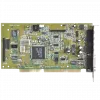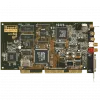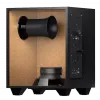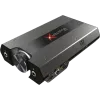Sound Blaster Drivers
The Sound Blaster family of sound cards was for many years the de facto standard for audio on the IBM PC compatible system platform, before PC audio became commoditized, and backward-compatibility became less of a feature, We have the largest collection of Sound Blaster Drivers on the web, if there is any information missing let us know.
The creator of Sound Blaster is the Singapore-based firm Creative Technology, also known by the name of its United States subsidiary, Creative Labs.
The pre-Sound Blaster years
Creative Music System
The history of Creative sound boards started with the release of the Creative Music System ("C/MS") board in August 1987. It contained two Philips SAA 1099 circuits, which, together, provided 12 voices of square-wave bee-in-a-box stereo sound plus some noise channels.
These circuits were featured earlier in various popular electronics magazines around the world. For many years Creative tended to use off-the-shelf components and manufacturers' reference designs for their early products. The various integrated circuits had white or black paper sheets fully covering their top thus hiding their identity. On the C/MS board in particular, the Philips chips had white pieces of paper with a fantasy CMS-301 inscription on them; real Creative parts usually had consistent CT number references.
Surprisingly, the board also contained a large 40-pin PGA (Creative Technology Programmable Logic) integrated circuit, bearing a CT 1302A CTPL 8708 serigraphed inscription and looking exactly like the DSP of the later Sound Blaster.
Game Blaster
A year later, in 1988, Creative marketed the C/MS via Radio Shack under the name Game Blaster. This card was identical in every way to the precursor C/MS hardware. Creative did not change any of the labeling or program names on the disks that came with the Game Blaster, but also included a later revision of the game Silpheed that added support for the C/MS hardware.
First Sound Blasters: the right bundle
Sound Blaster 1.0
The first board bearing the Sound Blaster name appeared in 1989. In addition to Game Blaster features, it had an 11-voice FM synthesizer using the Yamaha YM3812 chip, also known as OPL2. It provided perfect compatibility with the then market leader AdLib sound card, which had gained support in PC games in the preceding years. Creative used the "DSP" acronym to designate the digital audio part of the Sound Blaster. This actually stood for Digital SOUND Processor, rather than the more common digital signal processor, and was really a simple micro-controller from the Intel MCS-51 family (supplied by Intel and Matra MHS, among others). It could play back monaural sampled sound at up to 23 kHz sampling frequency (approx. FM radio quality) and record at up to 12 kHz (approx. AM radio quality). The sole DSP-like feature of the circuit was ADPCM decompression.
The original card lacked an anti-aliasing filter, resulting in a characteristic "metal junk" sound. (This was rectified with the addition of two user-selectable filters in the later Sound Blaster Pro card.) It also featured a joystick port and a proprietary MIDI interface.
In spite of these limitations, in less than a year, the Sound Blaster became the top-selling expansion card for the PC. It achieved this by providing a fully AdLib-compatible product, with additional features, for the same, and often a lower, price. The inclusion of the game port, and its importance to its early success, is often forgotten or overlooked. PCs of this era did not include a game port. Game port cards were costly (around $50) and used one of a few expansion slot PCs had at the time. Given the choice between an AdLib card or a fully-compatible Sound Blaster card that came with a game port, saved you a slot, and included the 'DSP' for not much more in price, many consumers opted for the Sound Blaster. In-game support for the digital portion of the card did not happen until after the Sound Blaster had gained dominance.
Sound Blaster 1.5
Released in 1990, Sound Blaster 1.5 dropped the C/MS chips, which were no longer popular with game developers. Instead, the board had two empty sockets, which could be user upgraded by purchasing the C/MS chips directly from Creative.
Sound Blaster 1.6
The Sound Blaster 1.6 consisted of the Sound Blaster 1.5 board with C/MS chips pre-installed. This revision was indicated by a yellow sticker on the box, and may have been a stock clearing measure before the Sound Blaster 2.0 which dropped C/MS support entirely.
Sound Blaster 2.0
The final revision of the original Sound Blaster, Sound Blaster 2.0 added support for "auto-init" DMA, which assisted in producing a continuous loop of double-buffered sound output. The maximum sampling rate was increased to 44 kHz for playback, and 22 kHz for record. The 2.0's PCB-layout used more highly integrated components, both shrinking the board's size and reducing manufacturing cost.
Owners of previous revision Sound Blaster boards could upgrade their board by purchasing the V2.00 DSP chip from Creative Labs, and swapping the older DSP with the newer replacement. The upgraded board gained the same capabilities as the Soundblaster 2.0.
The Soundblaster 2.0 remained in Creative's product-line well into the early 1990s.
Sound Blaster MCV
Sound Blaster MCV was a version created for IBM PS/2 model 50 and higher, which had a MicroChannel bus instead of the more traditional ISA one. It did not contain sockets for the C/MS chips and was unreliable in the faster PS/2 systems.
Improved quality: stereo and 16 bits
Sound Blaster Pro
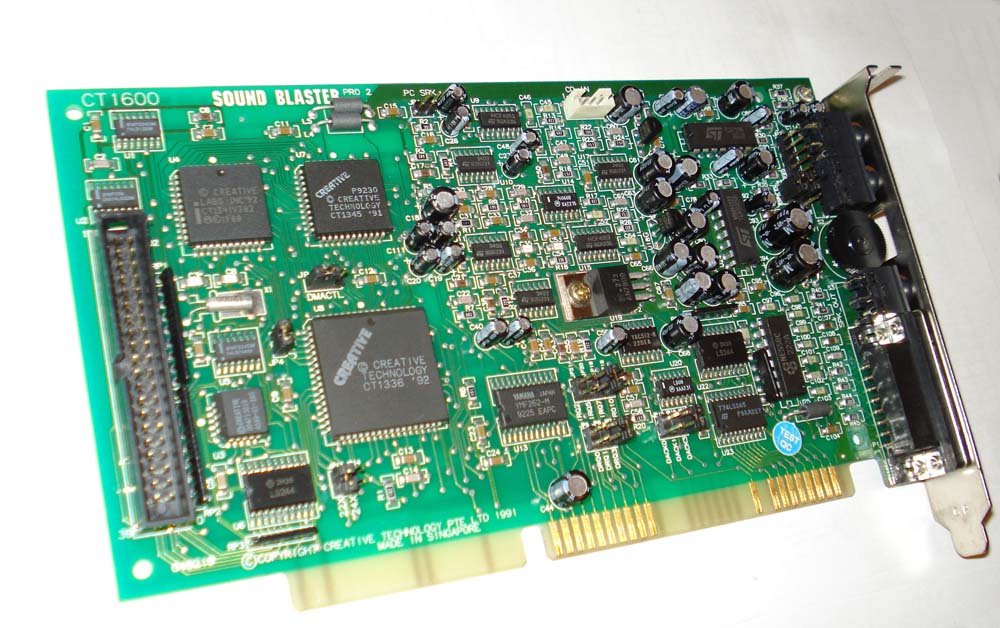
Sound Blaster Pro 2
The Sound Blaster Pro (May 1991) was the first significant redesign of the card's core features. The Sound Blaster Pro supported faster digital sampling rates (up to 22.05 kHz stereo or mono 44.1 kHz monoaural, added a "mixer" to provide a crude master volume control (independent of the volume of sound sources feeding the mixer), and a crude highpass or lowpass filter.
The original version of the Pro used a pair of YM3812 chips to provide stereo music-synthesis (one for each channel. A revised version (known as the Soundblaster Pro 2.0) replaced the YM3812s with a more advanced Yamaha YMF262 (OPL3). The Pro's MIDI UART was upgraded to full-duplex and offered time stamping features, but was not yet compatible with the MPU-401 interface used by professional MIDI equipment. Both versions of the Soundblaster Pro were fully backward compatible with the original Soundblaster, and by extension, the Adlib Music Card. Shortly after the relase of the 2.0 version, Creative discontinued the original Soundblaster Pro.
The Sound Blaster Pro was the first Creative sound card to have a built-in CD-ROM interface. Most Soundblaster Pros featured a proprietary interface for a Panasonic (Matsushita MKE) drive.
Creative also sold Multimedia Upgrade Kits containing the Soundblaster Pro. The kit bundled the soundcard, a Matsushita CD-ROM drive (model 531 for single-speed, or 562/3 for the later double-speed (2x) drives), and a several CD-ROMs of multimedia software titles. As CD-ROM technology and was new, the kit and included CD-ROM software represented a tremendous value to consumers. One such kit, named "OmniCD", included the 2x Matsushita drive along with an ISA controller card and software, including Software Toolworks Encyclopedia and Aldus PhotoStyler SE. It was compliant with the MPC Level 2 standard.
Packaged Sound Blaster cards were initially marketed and sold into the retail-channel. Creative's domination of the PC audiocard business soon had them selling bare Sound Blaster cards to OEM customers for integration into pre-assembled PCs.
Sound Blaster Pro 16 ASP
The next model, Sound Blaster 16 (June 1992) introduced 16-bit CD-quality digital audio sampling, an MPU-401 compatible UART, and an expansion-connector for MIDI daughterboards. It also had an additional socket for the optional Advanced Signal Processor (ASP or later CSP). The Yamaha OPL-3 for FM synthesis was retained, and the Soundblaster 16 was backward compatible with Soundblaster Pro 2.0 and Soundblaster software.
The expansion-connector allowed the SB16's music quality to be enhanced by a General MIDI daughterboard, such as the Wave Blaster. The daughterboard was logically connected to the SB-16's MPU-401 UART, allowing any MPU-401 aware game/application access to the installed daughterboard.
The Wave Blaster was a General-MIDI compatible sequencer. It used sample-based synthesis supporting up to 32 note polyphony, with an instrument sample set stored in 2MB of onboard ROM. A SB16 equipped with Waveblaster allowed users to hear the General MIDI tracks in supported games. Roland sold a competing daughterboard for the SB16, the SCDB (Sound Canvas Daughterboard.)
Eventually this design proved so popular that Creative made a PCI version of the card. This required a work-around to maintain backward compatibility with DOS programs. Moving the card off the ISA bus, which was already long in the tooth, negated the need for a DMA (Direct Memory Access) Line, which is still needed for DOS sound support.
Vibra 16
Vibra 16 was an inexpensive single-chip implementation of the ISA SB16 for OEM market. Creative Labs also used this chip for the Sound Blaster 32, Sound Blaster VIBRA + FM and many other value-edition cards. This series included the Vibra16 (CT2501), Vibra16s, Vibra16c (CT2505) PnP and Vibra16XV (CT2511) chips.
Sound Blasters with onboard wavetable synthesis
Sound Blaster AWE32
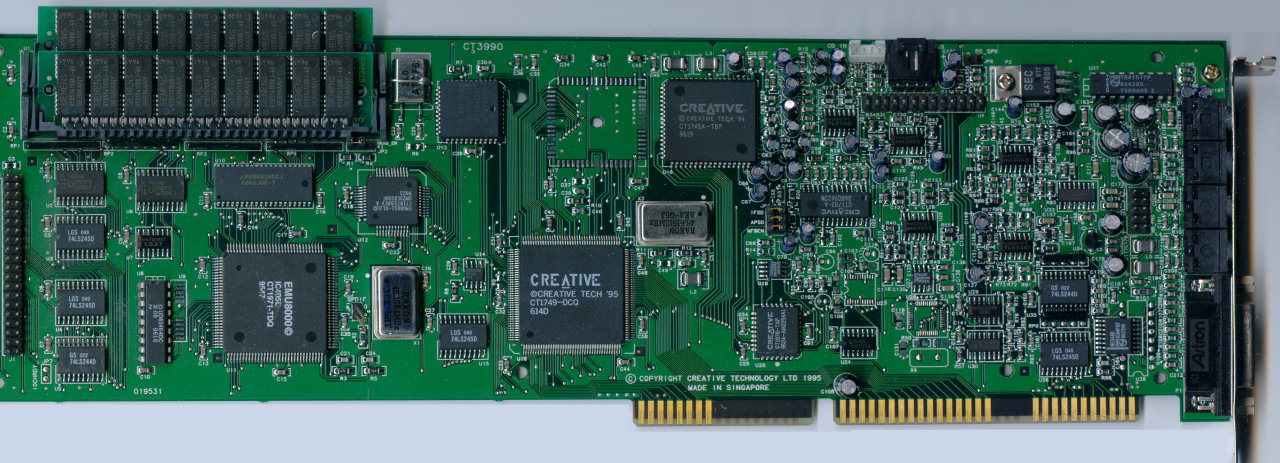
Released in March 1994, the Sound Blaster AWE32 (Advanced Wave Effects) introduced an all new MIDI synthesizer section based on the EMU8000. The AWE32 consisted of two distinct audio sections; the Creative digital audio section (audio codec, optional CSP/ASP chip socket, Yamaha OPL3), and the E-mu MIDI synthesizer section. The synthesizer section consisted of the EMU8000 sampler and effects processor, an EMU8011 1 MiB sample ROM, and 512 kiB of sample RAM (expandable to 28 MiB). To fit the new hardware, the AWE32 was a full-length ISA card, measuring 14 inches (356 mm).
Sound Blaster 32
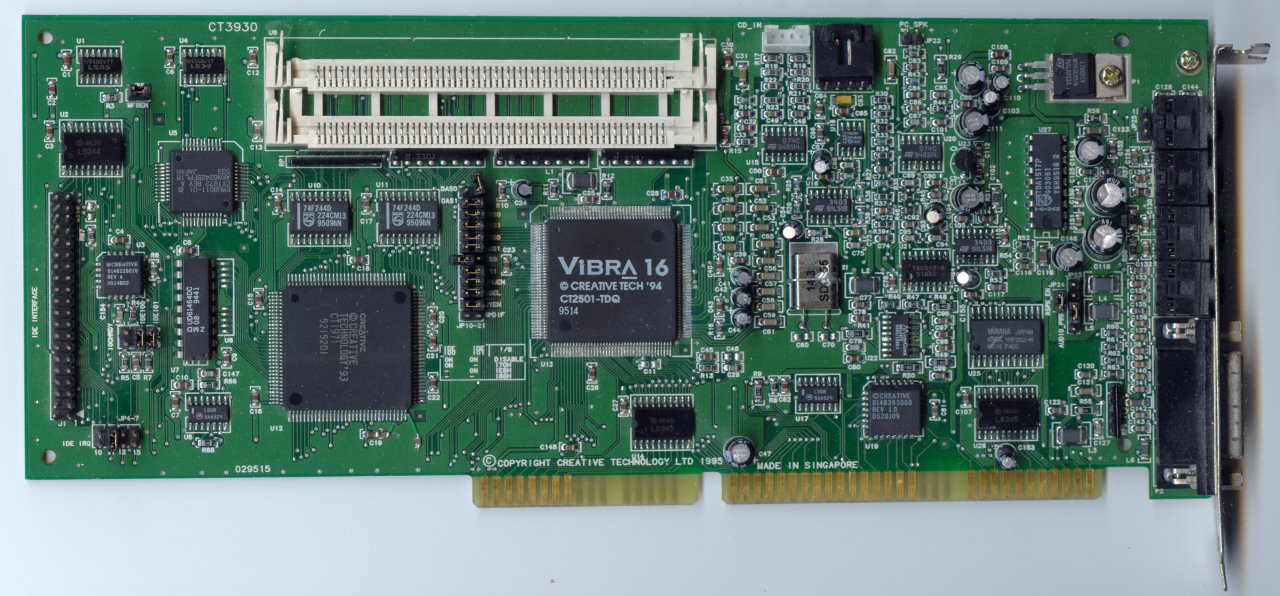
A derivative of the AWE32 design, the Sound Blaster 32 (SB32) was a value-oriented offering from Creative. Announced on June 6, 1995, the SB32 became the new entry-level card in the AWE32 product-line (previously held by the AWE32 Value.) The SB32 retained the AWE32's EMU8000/EMU8011 MIDI-synthesis engine and built-in instrument ROM, but dropped the onboard RAM, the Wave Blaster header, and the CSP port. The SB32 used the Vibra chip to reduce component count, which meant bass/treble/gain control was limited compared to the AWE32. The loss of onboard RAM is offset by the inclusion of 30-pin SIMM RAM sockets, which allow up to 8MB RAM to be installed and used by the EMU engine.
Sound Blaster AWE64
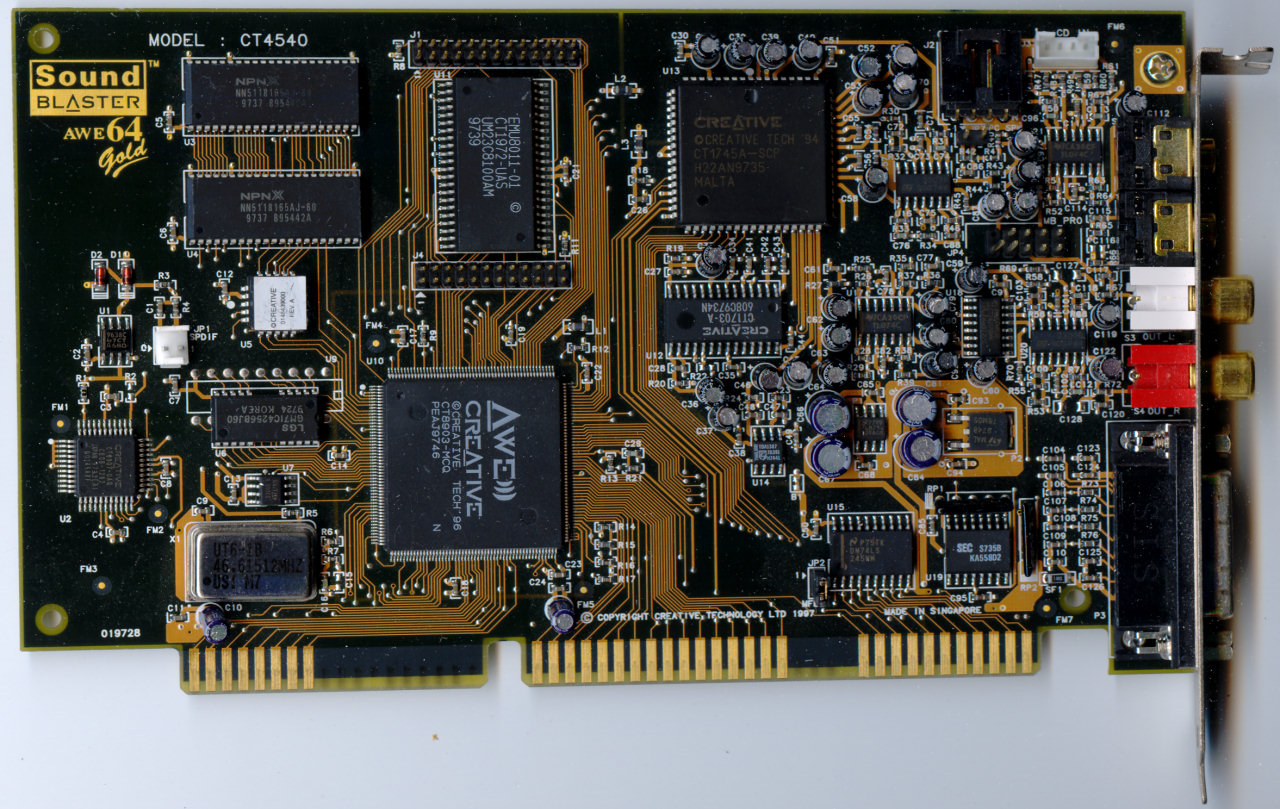
The AWE32's successor, the Sound Blaster AWE64 (November 1996), was significantly smaller, being a "half-length ISA card" ( that term is misleading - see the pictures for size comparison ) . It offered similar features to the AWE32, but also had a few notable improvements, including support for greater polyphony, although this was a product of 32 extra software emulated channels. The 30-pin SIMM slots from AWE32/SB32 were replaced with a proprietary memory format which could be (expensively) purchased from Creative.
The main improvements were better compatibility with older SB models, and an improved signal-to-noise ratio. The AWE64 came in 3 versions: A Value version (with 512KB of RAM), a Standard version (with 1 MB of RAM), and a Gold version (with 4 MB of RAM and a separate S/PDIF output).
Multi-channel sound and F/X
Ensoniq AudioPCI-based cards
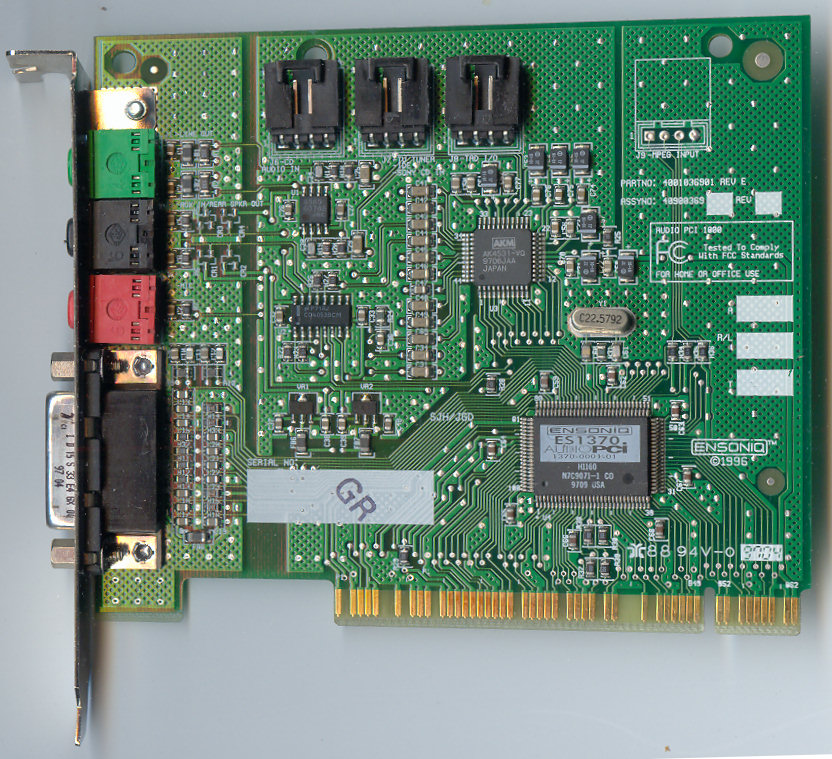
In 1998, Creative acquired Ensoniq Corporation, manufacturer of the AudioPCI, a card popular with OEMs at the time. AudioPCI offered a full-featured solution, being a PCI sound card with wavetable MIDI, and offering 4-speaker DirectSound3D surround sound, A3D emulation, and full DOS legacy support. Creative's acquisition filled a market segment where Live! was too expensive, and it gave them excellent DOS support, a feature that was proving difficult for companies to get working with PCI cards (typically early PCI audio cards were limited to DOS boxes within Windows 9x.)
Creative released many cards using the original AudioPCI chip, Ensoniq ES1370, and several boards using revised versions of this chip (ES1371 and ES1373), and some with relabeled AudioPCI chips (they say Creative on them.) Boards using AudioPCI tech are usually easily identifiable by the board design and the chip size because they all look quite similar. Such boards include Sound Blaster PCI64 (April 1998), PCI128 (July 1998), Creative Ensoniq AudioPCI, Vibra PCI and Sound Blaster 16 PCI.
These cards were full-featured, but the features were limited in capability. MIDI, for example, was rather poor in quality and there was no ability to customize the sample sets beyond the 3 pre-made sets (2, 4, and 8 MB) included with the cards. The chips do not support hardware acceleration of any kind as they are entirely software-driven. These cards also did not support SoundFonts.
Sound Blaster PCI512
The Sound Blaster PCI512 is an EMU10K1-based sound card designed to fill a lower cost segment than the Live! Value. It is capable of most of the Live! Value's features aside from being limited to 512 MIDI voice polyphony (a software-based limitation), lacking digital I/O, removal of expansion headers, and only stereo or quadraphonic output support. The card's circuit layout is somewhat simpler than that of the Live! series.
Sound Blaster Live! (Original)
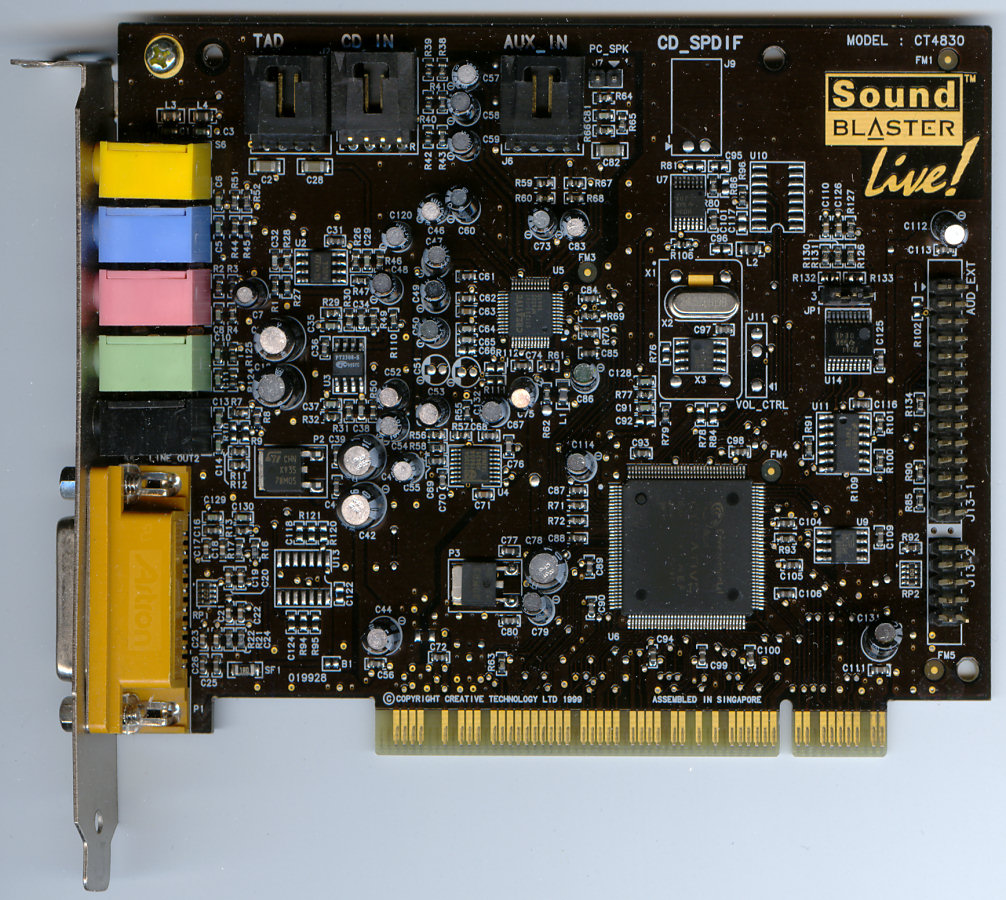
Sound Blaster Live! (August 1998) saw the introduction of the EMU10K1 processor, a 2.44 million transistor DSP capable of 1000 MIPS for audio processing. The use of a programmable digital signal processor in a broad consumer audio card was largely unprecedented at the time (professional Turtle Beach cards used them). The EMU10K1 and FX8010 chips provided the ability to offload functions previously reliant on custom creative chipsets. The EMU10K1 provided a high-speed DMA interface, which only required a single extra chip to interface with the PCI bus, allowing the realisation of a ROM-free virtualised wavetable in dynamic system memory which could be added to and remapped whilst in use.
Because of this, the EMU10K1 represented a paradigm shift in PC audio and proved to be a highly marketable product that was significantly cheaper to manufacture and update with new features/bug fixes and co-bundled musician-targeted applications and further income-generation through third party licensing. The main features prominent to most non-musicians were EAX 1.0 (and later 2.0) (environmental audio extensions, which competed with A3D before the demise of the latter), a high-quality 64-voice sample-based synthesizer (a.k.a. wavetable), with self-produced or third-party customized patches or "Soundfonts", and the ability to resample the audio output as input and apply a range of real-time DSP effects to any set of audio subchannels present in the device. All the original series of SB Live! came standard with 4-channel analog audio outputs and standard AC'97 chip features, and the ubiquitous 15-pin MIDI/Joystick multiport.
The first model on the market, the retail SB Live! Gold, featured gold tracings on all major analog traces and external sockets, along with an EMI-suppressing printed circuit board substrate and lacquer. It came standard with a daughterboard that implemented a separate 4-channel alternative mini-DIN digital output to Creative-branded internal-DAC speaker sets, a S/P-DIF digital audio Input and Output with separate software mappings, and a fully decoded MIDI interface with an Input and Output provided on mini-DIN connectors for which a converter was provided, purportedly for direct plug-and-play for musicians. Like all other audio sources, the MIDI synthesis complete with Soundfonts could be "Rendered" inside a virtual environment (reverb, etc.), and the output recaptured directly in software, whilst performing.
The Sound Blaster Live! was marketed as featuring higher audio quality than previous Sound Blasters, since the majority of sound processing was in the digital domain, with Digital-to-Analog conversion/amplification taking place on separate chip packages to the EMU10K1 chipset and its digitally-noisy data bus to the FX8010 DSP chip, which were themselves further separated from PC system noise through a board-shielded PCI device controller. Sound Blaster Live! supported multi-speaker output, initially up to a 4-speaker setup (4 satellites and a subwoofer).
Sound Blaster Live! (later 5.1-channel revision)
Later versions of the Live!, usually called Live! 5.1, offered 5.1-channel support which adds a center channel speaker and LFE subwoofer output, most useful for movie watching. The Live! 5.1 could also use one of the 3.5 mm jack ports as an SPDIF out, which allowed the connection of an external decoder.
Sound Blaster Audigy series
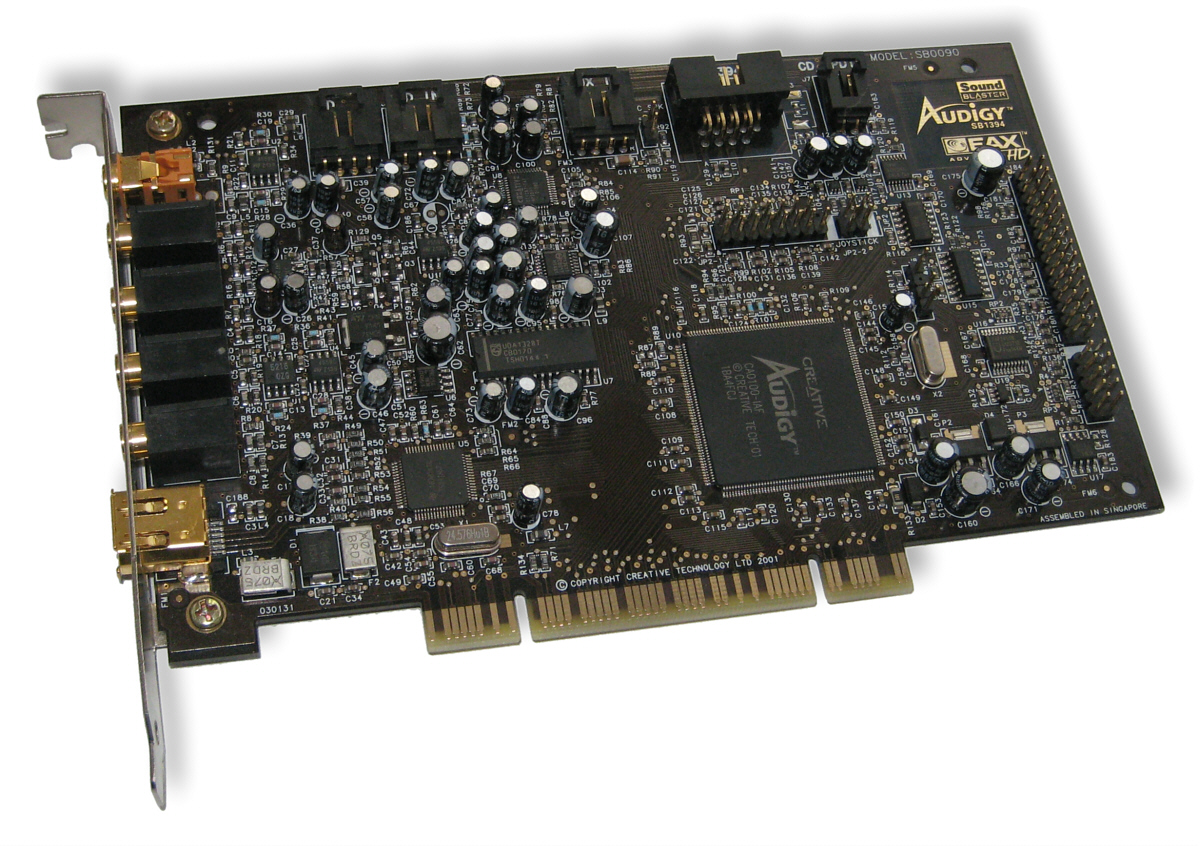
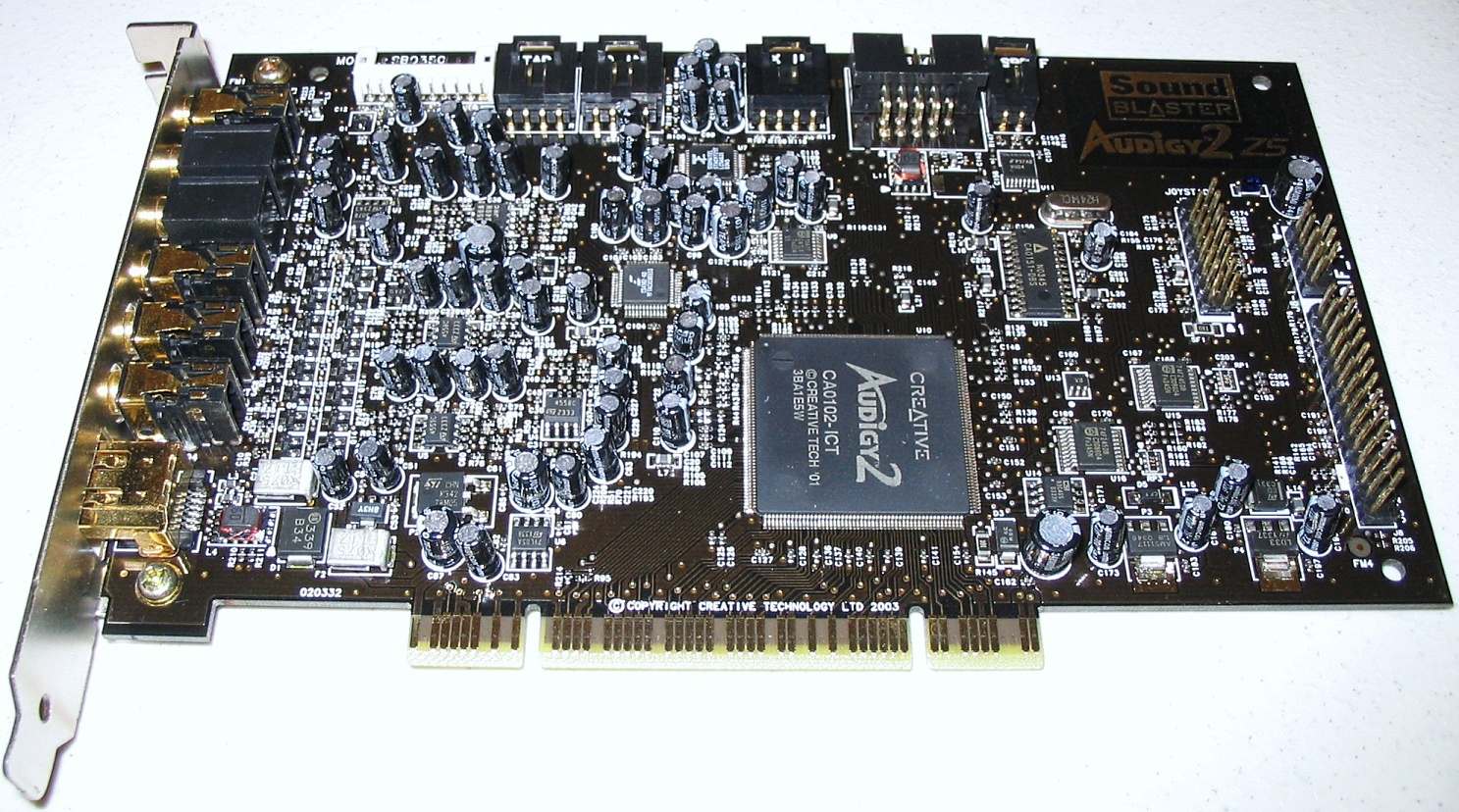
The Sound Blaster Audigy (August 2001) featured the Audigy processor (EMU10K2), an improved version of the EMU10K1 processor that shipped with the Sound Blaster Live!. The Audigy could process up to 4 EAX environments simultaneously with its upgraded on-chip DSP and native EAX 3.0 ADVANCED HD support, and supported from stereo up to 5.1-channel output.
The Audigy was advertised as a 24-bit sound card. However, with some controversy, the Audigy's audio transport (DMA engine) was fixed to 16-bit sample precision at 48 kHz (like Live!), and all audio had to be resampled to 48 kHz in order to be rendered through its DSP, or recorded from its DSP.
Sound Blaster Audigy 2 (September 2002) featured an updated EMU10K2 processor, sometimes referred to as EMU10K2.5, has a new audio transport (DMA engine) that could support playback at 24-bit precision up to 192 kHz (2-channel only. 6.1 limited to 96 kHz) and recording at 24-bit precision up to 96 kHz. In addition, Audigy 2 supported up to 6.1 (later 7.1) speakers and had improved signal-to-noise ratio (SNR) over the Audigy (106 vs. 100 decibels (A)). It also featured built-in Dolby Digital EX 6.1 and 7.1 decoding for improved DVD play-back.
Sound Blaster Audigy 2 ZS (2004) is essentially an Audigy 2 with updated DAC and opamps. Audigy 2 ZS uses the Cirrus Logic CS4382 DAC together with the opamps and can produce an output SNR of 108dB. There were a few slight printed circuit board modifications and 7.1 audio support was added.
Sound Blaster Audigy 4 Pro was an Audigy 2 ZS with updated DACs and ADCs, the new DAC is the Top of the line Cirrus Logic CS4398, boosting the output SNR to 113dB. Other than a breakout box, it has no distinguishable difference from the Audigy 2 ZS. The DSP is identical to the Audigy 2 ZS's but Creative put an "Audigy 4" sticker to cover the chip, making it appear as if it is a new chip. The Audigy 4 Pro is not to be confused with the Audigy 4 (Value) which contains lower quality DACs and does not have golden plated jacks. The Audigy 4 (Value) is more in line with the Audigy 2 Value series. The Audigy 4 enjoyed a relatively short life span because of the imminent debute of the Soundblaster X-Fi.
Sound Blaster X-Fi
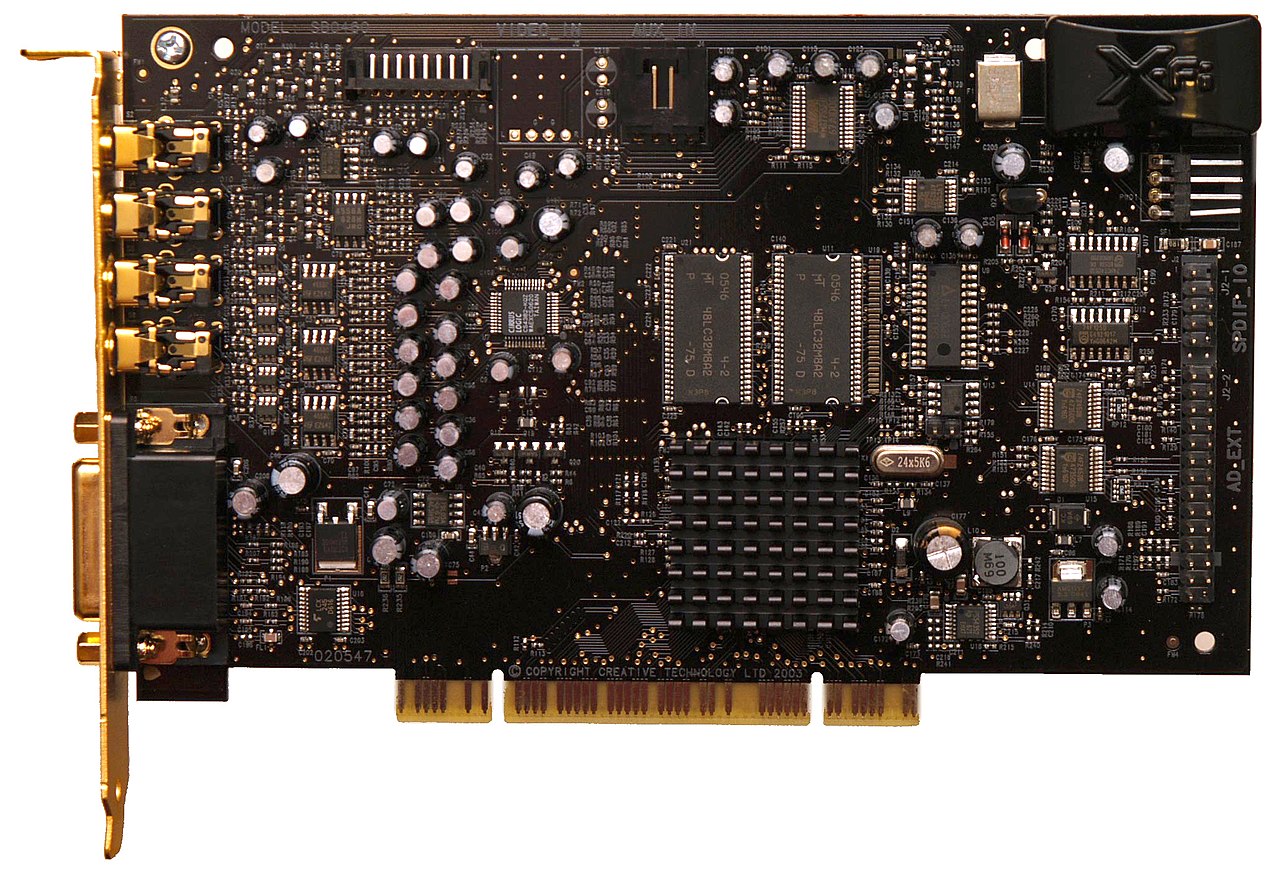
The X-Fi (for "Extreme Fidelity") was released in August 2005 and currently comes in XtremeGamer, Titanium, Titanium Fatal1ty Professional, Titanium Fatal1ty Champion and Elite Pro configurations. The 130 nm EMU20K1 (or EMU20K2 for Titanium series models) audio chip operates at 400 MHz and has 51 million transistors. The computational power of this processor, i.e. its performance, is estimated as 10,000 MIPS (million instructions per second), which is about 24 times higher than the estimated performance of its predecessor – the Audigy processor. It is interesting to note that the processor’s computational power is optimized for the work mode selected in the software. With the X-Fi's "Active Modal Architecture" (AMA), the user can choose one of three optimization modes: Gaming, Entertainment, and Creation; each enabling a combination of the features of the chipset. The X-Fi uses EAX 5.0 which supports up to 128 3D-positioned voices with up to four effects applied to each. This release also included the 24 bit crystalizer, which is intended to pronounce percussion elements by placing some emphasis on low and high pitched parts of the sound. The X-Fi, at its release, offered some of the most powerful mixing capabilities available, making it a powerful entry-level card for home musicians. The other big improvement in the X-Fi over the previous Audigy designs was the complete overhaul of the resampling engine on the card. The previous Audigy cards had their DSPs locked at 48/16, meaning any content that didn't match was resampled on the card in hardware; which was done poorly and resulted in a lot of intermodulation distortion. Many hardcore users worked around this by means of resampling their content using high quality software decoders, usually in the form of a plugin in their media player. Creative completely re-wrote the resampling method used on the X-Fi and dedicated more than half of the power of the DSP to the process; resulting in a very clean resample.
